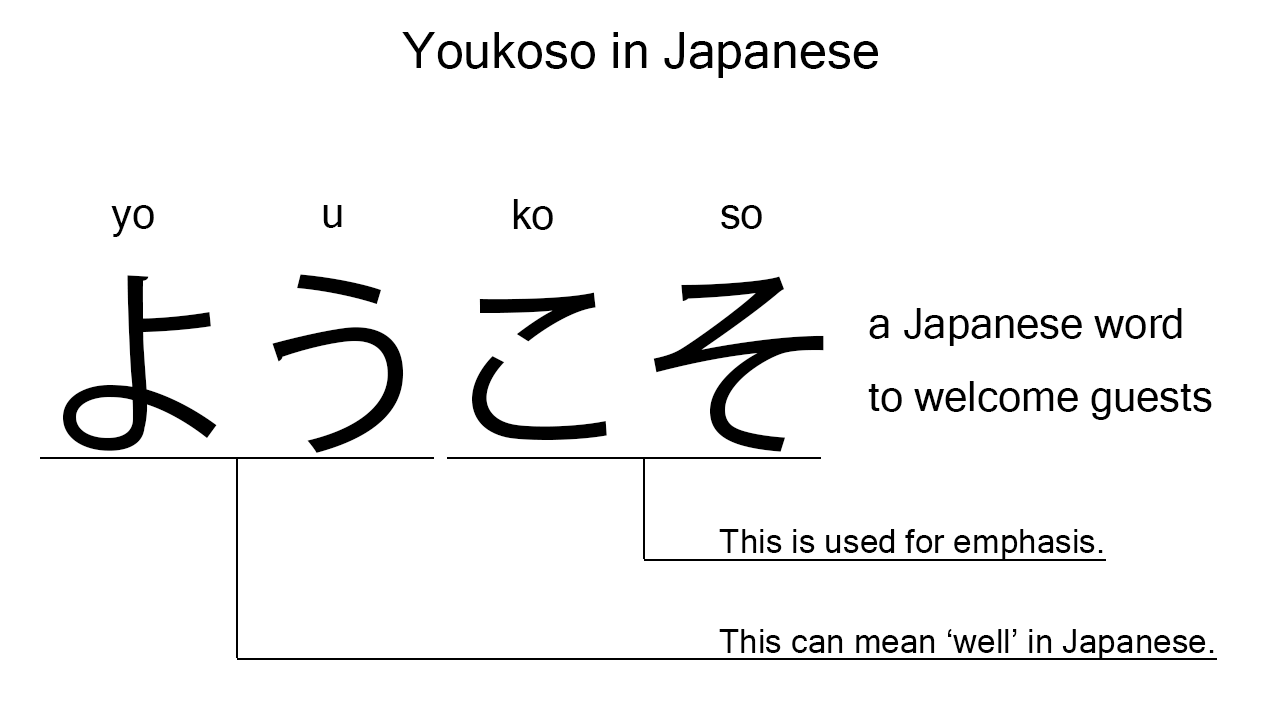What does “youkoso” mean in Japanese?
Japanese native speakers say “youkoso” to welcome guests politely. So, it means more or less ‘welcome’ in Japanese. Perhaps, some Japanese learners know this word as it is sometimes used in Japanese movies, songs, novels, manga, anime, and the like. In this blog post, however, I will explain this word in detail based on its grammatical components. And also, I will explain how to use it through example sentences. My explanations would help Japanese learners understand “youkoso” more clearly. Then, let’s get started!
Contents
Definition and meaning of “youkoso”
Let me start with the definition and meaning of “youkoso”.
- youkoso – ようこそ : an adverb, but often used as an individual word to welcome guests politely. Indeed, this is often translated into English as “welcome”.
Japanese native speakers use this word to welcome guests with a polite attitude. So, the usage of this word is very similar to that of “welcome” in English.
The definition and meaning are not that difficult, I think. To understand this word more clearly, however, let me explain its grammatical components in detail, one by one.
What does “youkoso” literally mean in Japanese?
“Youkoso” consists of the following two components:
- you – よう : a word derived from “yoku” which is one conjugation of the i-adjective, “yoi“, meaning ‘well’ or such in Japanese.
- koso – こそ : a binding particle used after a word for emphasis.
These two components tell us that “youkoso” is literally an emphasized expression which means ‘well’ in Japanese. This literal interpretation is not in line with the actual meaning and usage, but still understandable. To tell the truth, “youkoso” can work to admire what someone has done, besides welcoming guests. In a way, saying “welcome” in Japanese can be considered as telling guests “you well walked all the way to here,” for example.

When we meet new Japanese words, we should check their grammatical components in detail to understand their meanings clearly and deeply. In many cases, components tell us a lot about the meanings of the words they form. Actually, here, we could get the better understanding of “youkoso” through the detailed check above.
So far, I’ve explained the definition and meaning of “youkoso” together with its grammatical components. Then, let me explain how to use it through the example sentences below.
Example #1: how to say “welcome” in Japanese
watashi no ie ni youkoso – 私の家にようこそ (わたしのいえにようこそ)
Welcome to my home.
Below are the new words used in the example sentence.
- watashi – 私 (わたし) : a pronoun meaning ‘I’ in Japanese.
- no – の : a case particle used after a noun or pronoun to make its possessive case. In the example, this is used after “watashi” to make its possessive case, “watashi no“, which means ‘my’ in Japanese.
- ie – 家 (いえ) : a noun meaning ‘house’ or ‘home’ in Japanese. This can also work as plural. Learn more about Japanese plural.
- ni – に : a case particle used to say where someone or something goes. In the example, this is used after “watashi no ie” to say where the listener comes.
This is a typical usage of “youkoso”. In this example, it works together with the case particle, “ni”, to mean ‘welcome to’ in Japanese. Native speakers often use this combination, so it’s worth knowing.
Example #2: another usage of “youkoso”
kyou wa tokyo e youkoso – 今日は東京へようこそ (きょうはとうきょうへようこそ)
Welcome to Tokyo today.
Below are the new words used in the example sentence.
- kyou – 今日 (きょう) : a noun meaning ‘today’ in Japanese. This can also work as an adverb almost anywhere in a sentence.
- wa – は : a binding particle working as a case marker or topic marker. In the example, this works as a topic marker after “kyou” to put a focus on it.
- tokyo – 東京 (とうきょう) : a noun meaning ‘Tokyo’ in Japanese.
- e – へ : a case particle used to say where someone or something goes. In the example, this is used after “tokyo” to say where the listener comes.
This is another typical usage of “youkoso”. In this example, it works together with the case particle, “e”, which is very similar to “ni” used in the last example. When we want to welcome guests politely in Japanese, anyway, this word is always a very good option.
Summary
In this blog post, I’ve explained the definition and meaning of “youkoso” in detail based on its grammatical components. And also, I’ve explained how to use it through the example sentences. Let me summarize them as follows.
- youkoso – ようこそ : an adverb, but often used as an individual word to welcome guests politely. Indeed, this is often translated into English as “welcome”. This word consists of “you” and “koso”. These two components are literally an emphasized expression which means ‘well’ in Japanese. This literal interpretation is not in line with the actual meaning and usage, but still understandable. To tell the truth, “youkoso” can occasionally work to admire what someone has done, besides welcoming guests. In a way, saying “welcome” in Japanese can be considered as telling guests “you well walked all the way to here,” for example.
Hope my explanations are understandable and helpful for Japanese learners.